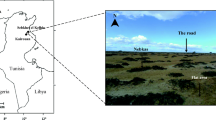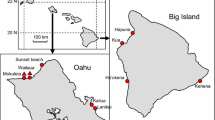Abstract
Helice tridens (De Haan) (Grapsidae) and Macrophthalmus japonicus (De Haan) (Ocypodidae) build separate burrows in reed marshes and muddy tidal flats, respectively, in the brackish-water estuaries of northeast Japan (38°11′N, 141°48′E). Habitat segregation between burrows of these two species was analysed by comparing the density of burrows of both species in their natural habitats, and on tidal flats subjected to various types of artificial treatment, in the summer of 1981 and 1982. Baskets, containing many stones, were placed on the ground in the reed marsh, tidal flat and creek and attracted many individuals of H. tridens, but not M. japonicus. When stones were placed on an area of tidal flat, H. tridens frequently formed burrows at the border between the stones and mud, suggesting that burrowing of H. tridens was related to the presence of solid substances lying on the ground, such as stones and shoots of the reed Phragmites australis (Cav.) Trin. In closed systems on the tidal flat and reed marsh, H. tridens and M. japonicus were able to construct burrows in both substrata regardless of high or low frequency. Moreover, it was recognized that H. tridens prevented the burrowing of M. japonicus in these closed systems. These results suggested that habitat segregation between H. tridens and M. japonicus burrows was caused primarily by an exclusive interaction between individuals of these two species.
Similar content being viewed by others
Literature cited
Bertness, M. D., Miller, T. (1984). The distribution and dynamics of Uca pugnax (Smith) burrows in a New England salt marsh. J. exp. mar. Biol. Ecol. 83: 211–237
Goshima, S., Izawa, M., Ono, Y. (1978). A preliminary study on the habitats and daily activities of some grapsid crabs and a land crab. Benthos Res. Japan. 15–16: 28–33 (In Japanese)
Hawkins, A. J. S., Jones, M. B. (1982). Gill area and ventilation in two mud crabs, Helice crassa Dana (Grapsidae) and Macrophthalmus hirtipes (Jacquinot) (Ocypodidae), in relation to habitat. J. exp. mar. Biol. Ecol. 60: 103–118
Henmi, Y. (1984). The description of wandering behaviour and its occurrence varying in different tidal areas in Macrophthalmus japonicus (De Haan) (Crustacea: Ocypodidae). J. exp. mar. Biol. Ecol. 84: 211–224
Jones, M. B., Simons, M. J. (1982). Habitat preferences of two estuarine burrowing crabs Helice crassa Dana (Grapsidae) and Macrophthalmus hirtipes (Jacquinot) (Ocypodidae). J. exp. mar. Biol. Ecol. 56: 49–62
Kurihara, Y., Sekimoto, K., Miyata, M. (1988). Wandering behaviour of the mud-crab Helice tridens related to evasion of cannibalism. Mar. Ecol. Prog. Ser. 49: 41–50
Okamoto, K., Kurihara, Y. (1987). Seasonal variation of population structure of Hemigrapsus penicillatus (De Haan) (Crustacea: Brachyura). Jpn. J. Ecol. (Nippon Seitai Gakkaishi) 37: 81–89
Ono, Y. (1959). The ecological studies on brachyura in the estuary. Bull. Mar. Biol. Stn. Asamushi 9: 145–148
Ono, Y. (1965). On the ecological distribution of ocypoid crabs in the estuary. Mem. Fac. Sci. Kyushu Univ. (Ser.) E 4: 1–60
Ringold, P. (1979). Burrowing, root mat density, and the distribution of fiddler crabs in the eastern United States. J. exp. mar. Biol. Ecol. 36: 11–21
Sato, M. (1979). The distribution of grapsoid crabs at Tatara Lagoon in Miyajima Island, southwestern Japan. Bull. Biol. Soc. Hiroshima Univ. Seibutsugakkaishi. 45: 33–37 (In Japanese)
Takeda, S., Kurihara, Y. (1987a). The distribution and abundance of Helice tridens (De Haan) burrows and substratum conditions in a northeastern Japan salt marsh (Crustacea: Brachyura). J. exp. mar. Biol. Ecol. 107: 9–19
Takeda, S., Kurihara, Y. (1987b). The effects of burrowing of Helice tridens (De Haan) on the soil of a salt-marsh habitat. J. exp. mar. Biol. Ecol. 113: 79–89
Takeda, S., Matsumasa, M., Kurihara, Y. (1988). Seasonal changes in the stomach contents of the burrowing mud-crab, Helice tridens (De Haan). Bull. Mar. Biol. Stn Asamushi 18: 77–86
Willason, S. W. (1981). Factors influencing the distribution and coexistence of Pachygrapsus crassipes and Hemigrapsus oregonensis (Decapoda: Grapsidae) in a California salt marsh. Mar. Biol. 64: 125–133
Author information
Authors and Affiliations
Additional information
Communicated by M. Anraku, Tokyo
Rights and permissions
About this article
Cite this article
Kurihara, Y., Hosoda, T. & Takeda, S. Factors affecting the burrowing behaviour of Helice tridens (Grapsidae) and Macrophthalmus japonicus (Ocypodidae) in an estuary of northeast Japan. Mar. Biol. 101, 153–157 (1989). https://doi.org/10.1007/BF00391454
Accepted:
Issue Date:
DOI: https://doi.org/10.1007/BF00391454




